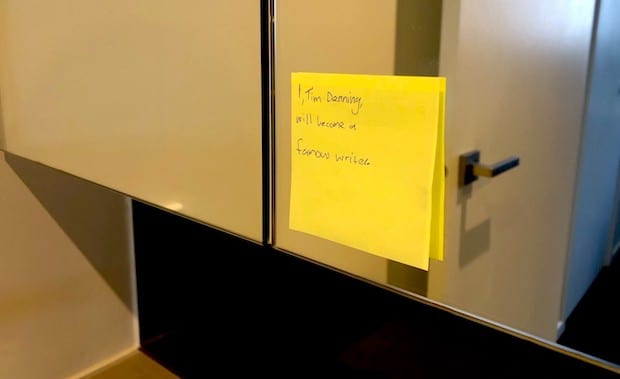Success Advice
How To Become Mind-Blowing At Public Speaking And Inspire People

As many of you know, public speaking has become something I want to get really proficient at. To achieve this goal, I have read and consumed the best public speaking tips from all of the experts in the field. I’ve also watched countless TED videos to see what makes a memorable experience for any audience.
Combined with my research, I’ve also attended many events where I have been left speechless by seemingly unknown speakers who manage to motive the audience into action and leave you feeling breathless after they share their stories and advice.
No matter what your pursuit is, at some point, if you want to take it to the next level, you’ll need to become outstanding at public speaking and sharing your message.
To fast track your progress, here are the 15 ways you can become mind-blowing at public speaking:
1. Do a back flip
No this is not the circus, and I know that. Our very own Joel Brown get’s people instantly connected to his talks by doing a back flip at the start and raising the audiences energy levels. This trick might seem a bit amateur, but it’s quite the opposite. What can you do to get people’s attention at the start of your talk?
2. Tell loads of stories
After countless hours of listening to and reading about what makes the best speech’s, it became clear to me that stories are at the heart of it all. Before you go out there and try and give the speech of your life, have a few stories that you can draw on depending on the mood of the room at the time.
Make these stories vulnerable and try to create a moment where people can get value and apply your lessons in their own life. Extract the best bits of each story and don’t waffle on too much about the detail. Focus on what the challenge was, and how you overcame it.
3. Paint images with your words
Highly successful speakers have a way with words. They use the words in their speech to paint a picture that makes you feel like you were present at the exact same moment. It’s easy to show images and videos in your talk; it’s much harder to create those images with words, and the effect is far greater.
4. Prepared speech or unprepared speech
The question that stumps all new public speakers is whether to prepare or not. The answer depends on what the purpose of your speech is. If it’s a TED talk, then you probably want to have a prepared speech where you memorise the key parts of the speech and say it on the fly.
Learning speeches word for word is near impossible, and I have racked by brain trying to do this. Read your speech as many times as you can and then start summarising different parts of the speech with key phrases.
Once you know the key phrases, then freestyle how you say it when you’re on stage. If you want to be a true professional, then the most advanced way of performing a speech is to do the whole thing on the fly.
To be successful with this technique, I’ve found that the topic of your speech has to be something that you know back the front and that you are extremely passionate about. When you try and speak without preparation about something that is not linked to your passion, you’ll find you will become frozen, nervous, and execute your speech poorly.
Even with an unprepared speech, it’s still a good idea to write down a few ideas you could potentially share and have some good stories that are front of mind to link to your main ideas.
5. Use silence instead of filler words
Despite what we all think, almost all public speakers lose track of where they are up to at some point throughout their speech. This is normal and not a time to panic. When you learn public speaking professionally, they teach you to cut out filler words like umm, so, ahh, etc.
What you learn instead is to use silence to get back on track. The reason we use filler words is that in conversations, we are scared of getting cutoff or not getting our point across so we try and maintain control of the conversations by filling in gaps of silence with filler words.
If you want to go pro, then you need to be conscious of filler words.
6. Use props
Some of the most interesting speeches on the internet use props to demonstrate the main points. Bill Gates did this when he spoke at TED and brought up how mosquito’s spread malaria. He then releases some live mosquitos into the audience, and people have no idea what’s going on.
The natural assumption by the audience is to think that the mosquitos in the room have malaria. Finally, Bill tell’s everyone that the mosquitoes are harmless, and he now has everyone’s attention. The other famous example is when Jamie Oliver spoke at TED and dropped a wheelbarrow full of sugar on the stage to demonstrate how much sugar is present in children’s food products like milk.
“Mind-blowing public speakers use more than just their voice to deliver their message; they use props to amplify what they’re saying and take their speech up another level”
7. Look the audience in the eye
The best public speakers all look their audience members in the eye to make their speech feel personal and relatable. For this technique to work, you have to look at audience members individually for a period of time before glancing at the next person.
Constantly moving your eye’s around will not give the desired effect – hold your glance.
8. Use big gestures
The heart of a good speech is not just the words that the speaker is saying it’s the body language they use. Big gestures that demonstrate the size of something or involve your hands and arms stretching out wide will add interest to what you’re saying.
Big gestures show confidence and create interest in your topic. These same gestures will also make the speaker feel pretty powerful and strong too!
9. Ask the audience questions
Every speaker has a day when they have more nerves than usual. The professionals use a simple hack to divert their attention away from their nerves and onto the audience. The simple hack is to ask your audience a question relevant to your topic. Let the audience member answer, and then begin your speech. By then, the nerves should have subsided, and you’ll be in flow.
10. Vary the speed of your flow
With any popular dance track, you’ll notice that there are peaks and troughs in the energy of the song. If a song is consistently pumping away at maximum energy for the whole time, then there is no rise and fall in emotion. Without emotion, music loses its soul.
The speed and flow of your speech are the same as a popular song. You need to vary the flow of your delivery and have really loud moments, and eloquent quiet moments. You also need to have bits where you speak fast and parts where you speak at a slower pace.
At the same time, world-class speakers understand the power of silence, and they use it after they present a significant point in their speech.
“Silence can add suspense and drama to any speech and it’s a must-have attribute of a memorable talk”
11. Move around the stage
Standing in one spot with your arms by your side is very boring to look at for the audience. Professional speakers who blow their audiences mind move around the stage and even walk into the audience to get up close and personal. Life is movement and so is public speaking.
12. Stand tall
Before you give a speech, you need to ensure you’re in a peak state. If you go out there slouching around and lack energy, the way you talk will carry the same forgettable elements. People want to be inspired when they hear you speak, and so you need to inspire yourself first.
Stand tall and imagine that nothing can stop you. Pretend that your message has the ability to save lives and bring about positive change. This mindset will see you crush your speaking goals, and it will create raving fans that want to come back and hear you again.
13. Practice in front of a video camera or smartphone
After speaking for a while and doing my first long form speech, a tip that I got from a friend was to video tape my speech. The idea is that when you are practicing your speech, you can film yourself to see how you will look on stage.
This exercise brings surprising results because you will pickup on the smallest details like unnecessary fidgeting and awkward poses or glances. These same videos can then be used later as content for your social media, website or blog so they will never go to waste!
14. Attend a speed dating public session event
To become mind-blowing at public speaking on the spot, I’ve found that there is an easy way to improve at impromptu speaking. What I did, was go to a public speaking Meetup where everyone in attendance has to speak on topics in front of each other.
The first few times it can be a challenge, but by the end, you get good at speaking on the fly and concentrating on your audience rather than your nerves. Impromptu speaking is the true definition of high quality, memorable, and inspiring speeches.
15. Learn to control your nerves
Everyone from politicians to Gary Vaynerchuk experience some form of nerves when doing public speaking. Nerves are energy that you can use to serve you or detract from your performance. Focus your attention on the audience, notice your nerves, and know that it’s all gravy. You’re meant to do this, and it doesn’t matter what people think anyway.
What do you think makes a fantastic public speaker? Let me know on my website timdenning.net or my Facebook.
Did You Know
How Skilled Migrants Are Building Successful Careers After Moving Countries
Behind every successful skilled migrant career is a mix of resilience, strategy, and navigating systems built for locals.

Moving to a new country for work is exciting, but it can also be unnerving. Skilled migrants leave behind familiar systems, networks, and support to pursue better job opportunities and a better future for their families. (more…)
Life
10 Research-Backed Steps to Create Real Change This New Year
This New Year could finally be the one where you break old patterns and create real, lasting change.

Every New Year, we make plans and set goals, but often repeat old patterns. (more…)
Change Your Mindset
The Silent Skill That Makes People Respect You Instantly
What truly earns respect and why most people go about it the wrong way

Everybody craves respect but not everyone earns it. Some people believe that a title, years of experience, or a position of authority automatically entitles them to respect. (more…)
Entrepreneurs
The Essential Skills Every Entrepreneur Needs In 2026
Success in the digital age isn’t about luck. It’s about mastering the skills that separate dreamers from doers.

When I was 22 years old, I started my first side hustle as a ghostwriter. (more…)
-

 Shift Your Mindset4 weeks ago
Shift Your Mindset4 weeks ago11 E’s That Define Every Great Leader And Why Most People Miss Them
-

 Did You Know4 weeks ago
Did You Know4 weeks agoThe Success Patterns You Inherited (And Didn’t Notice)
-

 Entrepreneurs3 weeks ago
Entrepreneurs3 weeks agoThe Essential Skills Every Entrepreneur Needs In 2026
-

 Business4 weeks ago
Business4 weeks agoThe Hidden Money Pit in Your Operations (and How to Use It)
-

 Change Your Mindset3 weeks ago
Change Your Mindset3 weeks agoHow to Turn Your Mind Into Your Greatest Asset (Instead of Your Enemy)
-

 Change Your Mindset2 weeks ago
Change Your Mindset2 weeks agoThe Silent Skill That Makes People Respect You Instantly
-

 Life2 weeks ago
Life2 weeks ago10 Research-Backed Steps to Create Real Change This New Year
-

 Tech2 weeks ago
Tech2 weeks agoWhat’s in a Name? How to Get Your Domain Right




















7 Comments